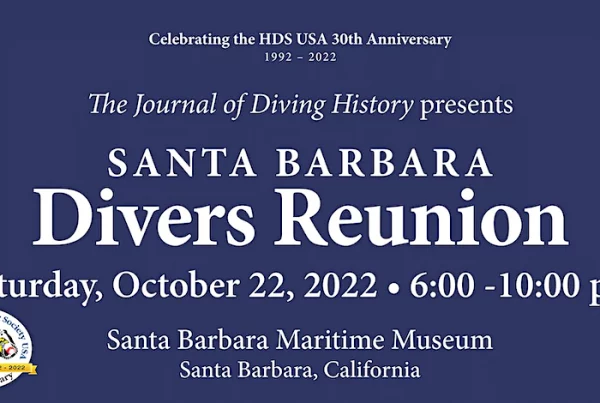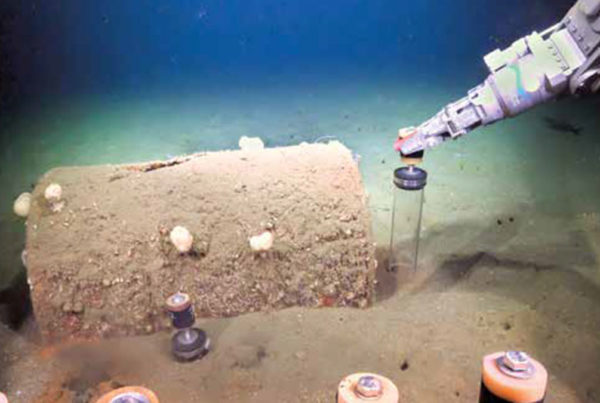 At-A-Glance
At-A-Glance
Skill Level: Intermediate and above. Kelp diving experience recommended.
Location: South side of San Miguel Island. Wyckoff Ledge N34°01.007’, W120°23.276’. Markers Reef N34°01.294’, W120°23.757’
Access: Boat only.
Depth Range: 25 to 80 feet
Conditions: Currents and swell
Visibility: Good, averaging 30 to 40 feet
Photography: Good macro and wide-angle photo ops
Hunting: poor
Cautions: Current can come up suddenly but is generally not strong. Thick kelp. Cold water temps.
Once we’d descended through the thick kelp and through a cloud of black rockfish, we could finally see the seafloor. The first thing that caught my eye was a big red abalone. It was fat and sassy, just sitting there out in the open. After snapping off a few photos I demonstrated to my buddy a trick I learned a number of years ago where you can get an abalone to “dance.” Breaking off a kelp frond I wiggled it in front of the abalone’s face (if you can call it that) and watched it reach out to grab the kelp. Teasing the abalone a bit, I pulled the kelp away and up. The abalone reached up to chomp on one of its favorite treats. Moving the kelp from side to side, we soon had a dancing abalone! I gave the abalone the kelp treat and felt grateful that they still exist off Southern California. A bit further on I spotted its brother, sister, cousin and aunt. One uncle was particularly large, spanning over an estimated nine inches! They were all over the place.
San Miguel Island is the last refuge of a substantial population of red abalone brought close to elimination by overfishing and disease in the late and mid 1990s. Since 1997 all abalone, including these reds, have been protected in central and southern California. Very recently, seeing the need for additional protection, the take of red abalone along the North Coast is now closed. But seeing the population here at San Miguel Island gave me hope that the red abalone will once again repopulate much of the Channel Islands and perhaps even the rest of California. This will only happen if they are left alone to breed and spread, but abalone are slow to reproduce so this will likely take several decades.
San Miguel Island is what I would call pure underwater wilderness. It is virgin California diving at its best. What keeps most people away is its location. It is the furthest west of the Channel Islands and outside the protection of Point Conception on the mainland. Strong wind and waves from the northwest make for challenging conditions, and in many instances San Miguel is too rough for diving. It takes an experienced skipper to visit this island; a professional dive charter operation is highly recommended. Truth Aquatics out of Santa Barbara with its three boats — the Truth, Conception and Vision — are an excellent choice as is the dive boat Peace out of Ventura.
Tyler Bight is on the south side of the island and is especially wonderful due to its protection from prevailing northwest weather. Ashore is the only elephant seal rookery in the southern section of the state. Sea lions breed and give birth here as well. Underwater encounters with young sea lions are almost guaranteed. Big aggressive males sometimes also give divers a fly-by. They are usually harmless but pay heed if a big male “warns” you with a charge and a burst of bubbles. You’d be wise to back away, quickly.
Offshore from the breeding grounds are a number of beautiful kelp forests and spectacular reefs. Perhaps the most noteworthy of these reefs is Wyckoff Ledge where an underwater ridge drops off from as little as 20 feet vertically to over 70 feet. Wyckoff Ledge is located on the eastern perimeter of the semi-bay. The best drop-off is the northwestern facing portion of the wall.
Another excellent dive in the area is Markers Reef lying a short distance to the west. Although not as spectacular as Wykcoff, it also shows off some excellent walls, mini-walls and tall pinnacles. It too has the best portion of the reef facing northwest. The kelp forest here is also thick and healthy.
This spot is covered with many excellent macro subjects. There are the ubiquitous Spanish shawl nudibranchs, along with a variety of other nudibranchs, including dorids in many forms. Then there are Hermissenda and Hilton’s aeloid. On my most recent dive I came across a small group of Chromodorids, my personal favorites. Small colorful fish also dot the reef including numerous painted greenlings as well as blennies, fringe heads and more.
Wide-angle photo opportunities are abundant in the kelp forest dotted with numerous fish. The many ledges, several blanketed by brightly hued sponges and anemones, present interesting angles.
Surprisingly, this is not a very good hunting area. Lobsters are rare as are rock scallops. Lingcod are present but most are small.
It’s a bit of a cruise to reach San Miguel Island, but it has some of the best California wilderness diving there is to offer.









